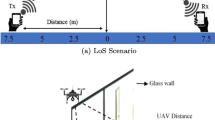Abstract
In this paper, Unmanned Aerial Vehicles are used for establishing an airborne communication relay chain to extend the communication range or to obtain a channel between two far points which are outside the single UAV communication range. Positions of the UAVs in the chain are detected by the vehicles autonomously and while establishing the suitable formation, collision avoidance between vehicles and other geographical obstacles are considered by using artificial potential fields. Especially to provide reliable continues communication between vehicles as uninterrupted channels, positions of the UAVs which are providing line of sight, calculated automatically by tuning artificial potential field parameters dynamically. The success of this novel approach is expressed by simulation studies in Matlab environment and the simulation results are validated using NS2 simulator.
Similar content being viewed by others
References
Eyes of the Army Roadmap for UAS 2010–2035: U.S. Army UAS Center of Excellence (2010)
de Freitas, E.P., et al.: UAV relay network to support WSN connectivity. In: 2010 International Congress on Ultra-Modern Telecommunications and Control Systems and Workshops (ICUMT), 18–20 Oct 2010
Cetin, O., Zagli, I.: Continuous airborne communication relay approach using unmanned aerial vehicles. J. Intell. Robot. Syst. 65(1–4), 549–562 (2012)
Pinkney, M.F.J., Hampel, D., DiPierro, S.: Unmanned aerial vehicle (UAV) communications relay. In: MILCOM ’96, Conference Proceedings, IEEE, Military Communications Conference, vol. 1, pp. 47–51, 21–24 Oct 1996
Ahmed, N., Kanhere, S., Jha, S.: Link characterization for aerial wireless sensor networks. In: Wi-UAV 2011, 2nd International Workshop on Wireless Networking for Unmanned Autonomous Vehicles: Architectures, Protocols and Applications, Texas, USA, 5–9 December 2011
Zagli, I., Cetin, O., Yilmaz, G.: Obstacle free airborne communication relay approach by using autonomous unmanned aerial vehicles. In: 2012 International Conference on Unmanned Aircraft Systems (ICUAS’12), Philadelphia, PA USA, 12–15 June 2012
Cetin, O., Kurnaz, S., Kaynak, O., Temeltes, H.: Potential field based navigation task for autonomous flight control of UAVs. IJAAC 5(1), 1–21 (2011)
Cosío, F.A., Castañeda, M.A.P.: Autonomous robot navigation using adaptive potential fields. Math. Comput. Model. 40(9–10), 1141–1156 (2004)
Vaščak, J.: Navigation of mobile robots using potential fields and computational intelligence means. Acta Polytechnica Hungarica Journal 4(1), 63–74 (2007)
Khatib, O.: Real time obstacle avoidance for manipulators and mobile robots. Int. J. Rob. Res. 5–1, 90–99 (1986)
Koditschek, D.E.: Exact robot navigation by means of potential functions: some topological considerations. IEEE Int. Conf. Robot. Autom. 4, 1–6 (1987)
Krough, B.H., Thorpe, C.E.: Integrated path planning and dynamic steering control for autonomous vehicles. IEEE Int. Conf. Robot. Autom. 3, 1664–1669 (1986)
Brooks, R.A.: A robust layered control system. IEEE J. Robot. Autom. 2(1), 14–23 (1986)
Arkin, R.C.: Towards cosmopolitan robots: intelligent navigation in extended man-made environments. Technical reports COINS Department, University of Massachusetts (1987)
Borenstein, J., Koren, Y.: The vector field histograms fast obstacle avoidance for mobile robots. IEEE Trans. Robot. Autom. 7, 278–288 (1991)
Connolly, C.I.: Harmonic functions and collision probabilities. Int. J. Rob. Res. 16–4, 497–507 (1997)
Masoud, A.A., Masoud, S.A.: Motion planning in the presence of directional and obstacle avoidance constraints using nonlinear, anisotropic, harmonic potential fields. In: Proceedings of the IEEE International Conference on Robotics & Automation, vol. 3, pp. 2944–2951 (2000)
Liberti, J.C., Rappaport, T.S.: A geometrically based model for line-of-sight multipath radio channels. In: IEEE 46th Vehicular Technology Conference. Mobile Technology for the Human Race, no. 2, pp. 844–848. Atlanta, GA, USA, 28 Apr–1 May 1996
The Network Simulator Software-NS2, http://www.isi.edu/nsnam/ns/ [Last accessed 01.03.2012]
Author information
Authors and Affiliations
Corresponding author
Rights and permissions
About this article
Cite this article
Cetin, O., Zagli, I. & Yilmaz, G. Establishing Obstacle and Collision Free Communication Relay for UAVs with Artificial Potential Fields. J Intell Robot Syst 69, 361–372 (2013). https://doi.org/10.1007/s10846-012-9761-y
Received:
Accepted:
Published:
Issue Date:
DOI: https://doi.org/10.1007/s10846-012-9761-y




